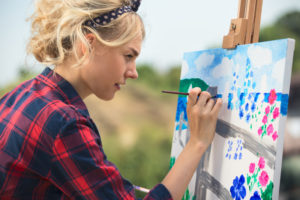 You have just finished painting a beautiful acrylic landscape. Or perhaps it’s a watercolor of lilies. It could be an oil painting of a horse or a pen-and-ink drawing of a cat. True, you can sell that original artwork once and make some money off of it. But before the artwork leaves your house, you should also try to get a high resolution, square-on photo of that artwork. That way you can make prints of it and sell those prints as well, either as limited edition prints or as a long-running revenue stream.
You have just finished painting a beautiful acrylic landscape. Or perhaps it’s a watercolor of lilies. It could be an oil painting of a horse or a pen-and-ink drawing of a cat. True, you can sell that original artwork once and make some money off of it. But before the artwork leaves your house, you should also try to get a high resolution, square-on photo of that artwork. That way you can make prints of it and sell those prints as well, either as limited edition prints or as a long-running revenue stream.
How do you do that?
Use an Online Service
The easiest way, although it’s also the most expensive, is to use an online service like FineArtAmerica.com. You set up an account there for free and load up the JPG versions of your artwork. You can then order copies in nearly any size you want, on a variety of types of paper or canvas. You can also offer your items for sale to the mass public through them. To see how this works, here is Lisa Shea’s account:
Many BVAA members have accounts here. They create high quality prints which will not fade.
Use a Local Service
As tempting as it is, you should avoid using Staples, Kinkos, CVS, and other similar services, unless you are ABSOLUTELY SURE they are using pigment-based inks in their printers. Most of them do NOT. Here is why pigment-based inks are important.
DYE-BASED INK: This is the cheap standard that most copy places, print shops, and home printers use. A dye-based ink soaks into the paper and is sensitive to light. If there is sunlight in the place the print is hung, that print will fade after a few months. That means the person who buys your print will watch that print vanish over time.
PIGMENT-BASED INK: This is the type of ink used in art printing. The pigment in the ink is just like the pigment in oil paints or acrylic paints. Pigment doesn’t fade under light. It will last past the owner’s lifetime. Yes, it costs a little more, because it is meant to actually survive on display.
The type of paper you use also matters. A glossy paper is more likely to fade than a matte paper will. So if you are printing with dye-based ink on glossy paper you are creating a situation where the image you are selling is going to fade much more quickly than other options. We are talking about the difference of the print fading in just a months vs lasting vibrantly for long decades.
So if you’re going to use a local service, it’s better to go with a photography shop or art shop where they understand these issues. If you go to your local Staples they will of course tell you “our prints last a long time!” They want your service. But they are used to cranking out banners for trade shows and that sort of thing. They aren’t thinking about a person hanging a work of art on their wall for years and wanting the image to remain crisp and vibrant.
Print Your Own
Many BVAA members print their own prints, whether they do photography, painting, or other types of art. If you’re going to print your own artwork, again, consider getting a printer which uses pigment-based ink. As mentioned above, dye-based ink is going to fade. If you sell a print made with dye-based ink it’s not going to last very long. That could lead to unhappy customers.
If you can’t get your own printer, talk with other BVAA members who do print their own. Maybe you can work out an arrangement!
Selling the Prints
Traditionally, prints made of artwork are sold as bin art, where they are matted and protected by a plastic bag. For photographers, these prints can often be created at a large size, framed, and sold in a wall-hanging-ready presentation.